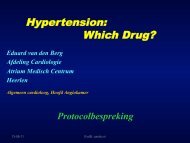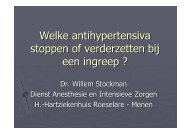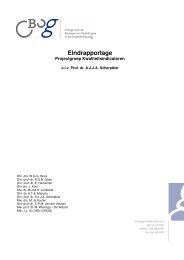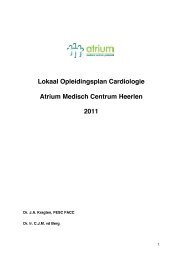Guidelines on the Management of Stable Angina Pectoris ... - Cardio
Guidelines on the Management of Stable Angina Pectoris ... - Cardio
Guidelines on the Management of Stable Angina Pectoris ... - Cardio
You also want an ePaper? Increase the reach of your titles
YUMPU automatically turns print PDFs into web optimized ePapers that Google loves.
ESC <str<strong>on</strong>g>Guidelines</str<strong>on</strong>g> 31such combinati<strong>on</strong> treatment have, however, not yet beendocumented.Lipid-modifying drugs o<strong>the</strong>r than statins, e.g. fibrates,resins, or prol<strong>on</strong>ged release nicotinic acid, and <strong>the</strong>ir combinati<strong>on</strong>swith statins and o<strong>the</strong>r hypolipidaemics may beneeded to c<strong>on</strong>trol <strong>the</strong> lipid levels am<strong>on</strong>g patients withsevere dyslipidaemia. This is especially true <strong>of</strong> those withlow levels <strong>of</strong> HDL cholesterol and high triglycerides.431,450,451 However, benefits <strong>of</strong> gemfibrozil treatmentin <strong>the</strong> VA-HIT study were primarily found am<strong>on</strong>g men withinsulin resistance. 452 The combinati<strong>on</strong> <strong>of</strong> fibrates withstatin <strong>the</strong>rapy increases <strong>the</strong> risk <strong>of</strong> associated myopathy,but fen<strong>of</strong>ibrate has been recently shown not to interferewith <strong>the</strong> catabolism <strong>of</strong> statins and is <strong>the</strong>refore less likelyto increase <strong>the</strong> risk <strong>of</strong> myopathy when combined with moderatedoses <strong>of</strong> statins. 453,454 Fibrate <strong>the</strong>rapy was not associatedwith reduced total deaths in <strong>the</strong> meta-analysis <strong>of</strong>Studer et al. 364 Similarly, <strong>the</strong> recently published FIELDtrial, comparing fen<strong>of</strong>ibrate and placebo in 9795 patientswith type 2 diabetes, found no mortality benefit and no significantreducti<strong>on</strong> <strong>of</strong> <strong>the</strong> primary combined endpoint <strong>of</strong> cor<strong>on</strong>arydeath and n<strong>on</strong>-fatal MI. 455 Thus, gemfibizol treatmentmay be c<strong>on</strong>sidered in high-risk patients with low HDL cholesterol,but <strong>the</strong>re is little support for a more widespread use<strong>of</strong> fibrates. Torcetrapib is a new agent which has beenshown to raise HDL effectively, 456 but as yet <strong>the</strong>re is insufficientevidence to make universal recommendati<strong>on</strong>s regardingtarget HDL or triglyceride levels to be achieved bypharmaco<strong>the</strong>rapy in <strong>the</strong> general populati<strong>on</strong> with angina.However, adjunctive <strong>the</strong>rapy to statin <strong>the</strong>rapy may bec<strong>on</strong>sidered <strong>on</strong> an individualized basis in patients who havesevere dyslipidaemia and remain at high risk after c<strong>on</strong>venti<strong>on</strong>almeasures (estimated cardiovascular mortality .2%per annum).ACE-inhibitors. ACE-inhibitors are well established for <strong>the</strong>treatment <strong>of</strong> hypertensi<strong>on</strong> and heart failure, but have notbeen shown to c<strong>on</strong>fer better overall protecti<strong>on</strong> against <strong>the</strong>cardiovascular complicati<strong>on</strong>s in hypertensi<strong>on</strong>, comparedwith that afforded by o<strong>the</strong>r antihypertensive drugs. 457–459ACE-inhibitors or angiotensin receptor blockers (ARBs) arerecommended for <strong>the</strong> treatment <strong>of</strong> diabetic patients withmicroalbuminuria to prevent progressi<strong>on</strong> <strong>of</strong> renal dysfuncti<strong>on</strong>,and as first-line agents to treat blood pressure indiabetic patients. 286,370Because <strong>of</strong> observed reducti<strong>on</strong>s in MI and cardiac mortalityin trials <strong>of</strong> ACE-inhibitors for heart failure andpost-MI, ACE-inhibitors have also been investigated as sec<strong>on</strong>darypreventive <strong>the</strong>rapy for patients with cor<strong>on</strong>arydisease without heart failure. 252,460,461 The HOPE studyincluded high-risk patients with established CVD (cor<strong>on</strong>aryor n<strong>on</strong>-cor<strong>on</strong>ary) or diabetes, and at least <strong>on</strong>e o<strong>the</strong>r riskfactor, and randomized <strong>the</strong>m to treatment with ramipril orplacebo for 5 years. 460 The EUROPA study included patientswith stable CAD, with a broad range <strong>of</strong> risk but without clinicalheart failure, who were randomized to treatment withperindopril or placebo for 4.2 years. 461 The PEACE studyincluded patients with stable CAD without heart failurewho were treated with trandolapril or placebo for 4.8years. 252 As shown in Figure 1, <strong>the</strong> annual cardiovascularmortality rates in <strong>the</strong> placebo groups ranged from 0.8%(PEACE) to 1.6% (HOPE). The differences in cardiovascularrisk were associated with differences in <strong>the</strong>rapy at baseline.The relative risk reducti<strong>on</strong>s for composite primary endpointswere in <strong>the</strong> order <strong>of</strong> 20% in <strong>the</strong> HOPE and EUROPAstudies, whereas <strong>the</strong> PEACE study found no significant riskreducti<strong>on</strong> with ACE-inhibiti<strong>on</strong>. The results <strong>of</strong> <strong>the</strong> threestudies are unfortunately not directly comparable due todifferent selecti<strong>on</strong>s <strong>of</strong> endpoints. Regarding reducti<strong>on</strong> <strong>of</strong><strong>the</strong> risk for cardiovascular death, HOPE reported a relativerisk reducti<strong>on</strong> <strong>of</strong> 26% (95% CI 13–36), EUROPA 14% (95% CI23 to 28), and PEACE 5% (95% CI 219 to 24). The greatestrelative risk reducti<strong>on</strong> in HOPE was seen for stroke (RR0.68; 95% CI 0.56–0.84), which was not reported in EUROPAbut tended to be reduced in PEACE (HR 0.76; 95% CI0.56–1.04). The PEACE investigators also reported norisk reducti<strong>on</strong> when using <strong>the</strong> combined endpoints <strong>of</strong>HOPE (RR 0.93; 95% CI 0.81–1.07) and EUROPA (RR 0.96;95% CI 0.83–1.12), respectively. 252 All three studies reportedsignificant reducti<strong>on</strong>s <strong>of</strong> heart failure with ACE-inhibitortreatment.Treatment benefits with ACE-inhibiti<strong>on</strong> were thus smallerin PEACE than in HOPE or EUROPA. One possible explanati<strong>on</strong>for this difference in outcomes might be differencesbetween <strong>the</strong> three ACE-inhibitors and/or <strong>the</strong> relativedosages used. However, <strong>the</strong> dosage <strong>of</strong> trandolapril used inPEACE was associated with a significant 25% reducti<strong>on</strong> <strong>of</strong>cardiovascular death and a 29% reducti<strong>on</strong> <strong>of</strong> severe heartfailure, but a lesser decrease in n<strong>on</strong>-fatal MI (214%, NS) inc<strong>on</strong>secutively enrolled post-MI patients with LV dysfuncti<strong>on</strong>in <strong>the</strong> TRACE study. 462 Baseline blood pressure was lower(133/78 mmHg) in <strong>the</strong> PEACE populati<strong>on</strong> than in ei<strong>the</strong>r <strong>of</strong><strong>the</strong> o<strong>the</strong>r two studies. The rates <strong>of</strong> previous revascularizati<strong>on</strong>ranged from 44% (HOPE) to 72% (PEACE), and drug<strong>the</strong>rapy at baseline differed between <strong>the</strong> studies.Lipid-lowering <strong>the</strong>rapy was received by <strong>on</strong>ly 29% <strong>of</strong> patientsin HOPE compared with 70% in PEACE; <strong>the</strong> corresp<strong>on</strong>dingfigures were 76 vs. 96% for antithrombotic drug treatmentand 40 vs. 60% for beta-blocker use. C<strong>on</strong>versely, calciumchannel blocker (CCB) use at baseline was more comm<strong>on</strong>in <strong>the</strong> HOPE study. Overall, PEACE patients were at lowerabsolute risk <strong>of</strong> cardiovascular death than <strong>the</strong> HOPE orEUROPA patients. These differences in baseline risk andn<strong>on</strong>-study-related <strong>the</strong>rapy may have c<strong>on</strong>tributed importantlyto <strong>the</strong> differences in cardiovascular outcome withACE-inhibitor <strong>the</strong>rapy.The relative effects <strong>of</strong> ramipril and perindopril <strong>on</strong> cardiovascularoutcome were similar in a high-risk populati<strong>on</strong> andan intermediate populati<strong>on</strong>, respectively, although forobvious reas<strong>on</strong>s, <strong>the</strong> ARR was greater in <strong>the</strong> populati<strong>on</strong> athighest absolute risk (MICRO-HOPE). 463 Pre-defined subgroupanalysis <strong>of</strong> EUROPA and HOPE according to individual factorsknown to affect risk, such as age, diabetes, prior MI, n<strong>on</strong>cor<strong>on</strong>ary vascular disease, and microalbuminuria, showedrelative benefit <strong>of</strong> similar magnitude from <strong>the</strong>rapy withACE-inhibitor in almost all subgroups.The blood pressure lowering effects <strong>of</strong> ACE-inhibiti<strong>on</strong> mayhave c<strong>on</strong>tributed to <strong>the</strong> beneficial results observed in HOPEand EUROPA. In HOPE, unc<strong>on</strong>trolled hypertensi<strong>on</strong> was anexclusi<strong>on</strong> criteri<strong>on</strong> and mean BP at entry was 139/79 mmHg. 460 The overall 3/2 mmHg blood pressure differencebetween ramipril and placebo treatment 460 may havebeen underestimated because <strong>of</strong> evening dosing <strong>of</strong> ramipriland <strong>of</strong>fice blood pressure measurements <strong>the</strong> next day. AHOPE substudy with 24 h ambulatory measurementsreported a 10/4 mmHg blood pressure difference during














